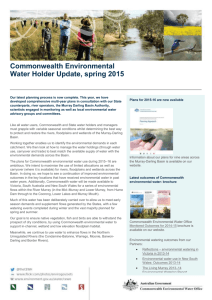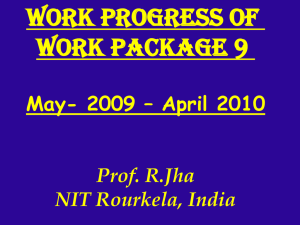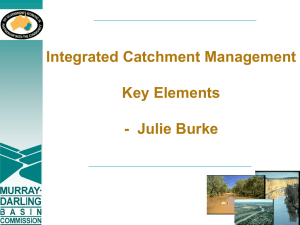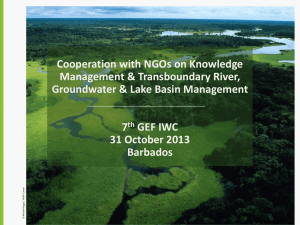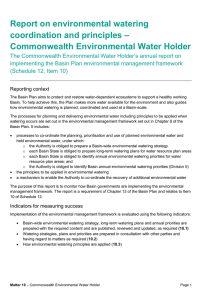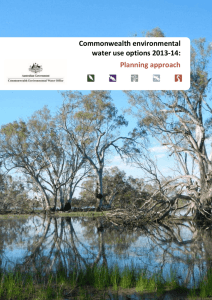Report on how local communities influenced Basin Plan
advertisement
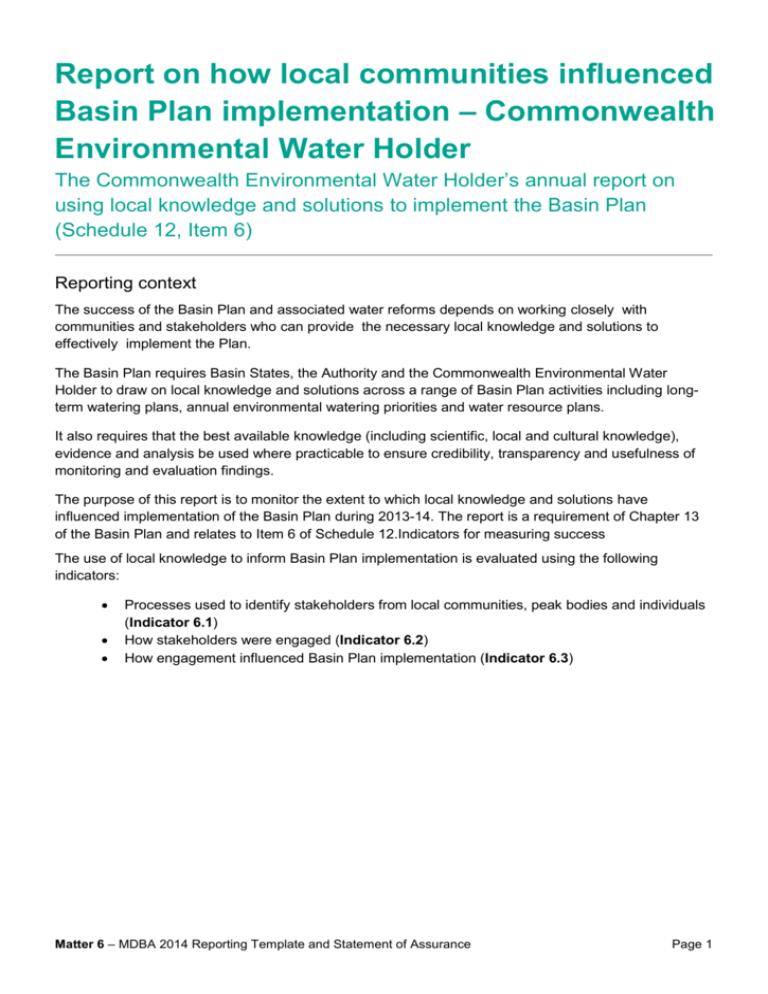
Report on how local communities influenced Basin Plan implementation – Commonwealth Environmental Water Holder The Commonwealth Environmental Water Holder’s annual report on using local knowledge and solutions to implement the Basin Plan (Schedule 12, Item 6) Reporting context The success of the Basin Plan and associated water reforms depends on working closely with communities and stakeholders who can provide the necessary local knowledge and solutions to effectively implement the Plan. The Basin Plan requires Basin States, the Authority and the Commonwealth Environmental Water Holder to draw on local knowledge and solutions across a range of Basin Plan activities including longterm watering plans, annual environmental watering priorities and water resource plans. It also requires that the best available knowledge (including scientific, local and cultural knowledge), evidence and analysis be used where practicable to ensure credibility, transparency and usefulness of monitoring and evaluation findings. The purpose of this report is to monitor the extent to which local knowledge and solutions have influenced implementation of the Basin Plan during 2013-14. The report is a requirement of Chapter 13 of the Basin Plan and relates to Item 6 of Schedule 12.Indicators for measuring success The use of local knowledge to inform Basin Plan implementation is evaluated using the following indicators: Processes used to identify stakeholders from local communities, peak bodies and individuals (Indicator 6.1) How stakeholders were engaged (Indicator 6.2) How engagement influenced Basin Plan implementation (Indicator 6.3) Matter 6 ‒ MDBA 2014 Reporting Template and Statement of Assurance Page 1 Indicator 6.1: Processes used to identify stakeholders from local communities, peak bodies and individuals Response The Commonwealth Environmental Water Holder (the CEWH) with the support of the Commonwealth Environmental Water Office (the CEWO) utilised existing Basin state, regional and local networks and structures to engage stakeholders to support the planning, delivery and monitoring of watering actions within the Murray-Darling Basin. The CEWO undertook a systematic process in January 2014, at the beginning of its annual planning, to identify the range of stakeholders that have an interest in Commonwealth environmental water management. An analysis was conducted to determine if these stakeholders were adequately represented through the existing state processes. Based on this analysis, the CEWO implemented additional complementary engagement mechanisms. In 2013–14, this included working with state government agencies on scoping opportunities for expanded joint engagement activities to target a broader range of stakeholders on environmental watering issues. The CEWO maintained a stakeholder engagement and feedback register, which identified stakeholders who had provided feedback to the CEWO, their interests and concerns, and whether they were interested in further engagement. In addition to the existing state and community networks, the CEWO used ‘open’ engagement mechanisms through which interested stakeholders put forward ideas or provided feedback on the management of Commonwealth environmental water. Engagement mechanisms included social media sites, the CEWO webpage and community and state processes. These open engagement mechanisms allowed stakeholders to self-select and engage directly with the environmental water management process. The CEWH and CEWO staff attended meetings with the Murray Lower Darling Rivers Indigenous Nations (MLDRIN) and the Northern Basin Aboriginal Nations (NBAN) to seek their advice and input on engaging with Indigenous communities in the Murray-Darling Basin. The CEWO commenced the recruitment of six Local Engagement Officers to be located in the Murray-Darling Basin towns of Deniliquin; Leeton, Dubbo, Mildura, Berri, and Goondiwindi. These officers will be hosted by land and water management agencies and will work closely with all levels of government as well as local communities and businesses across the range of catchments for which they will have responsibility. They will help identify opportunities to use Commonwealth environmental water to its best effect, locally and Basin-wide. Indicator 6.2: How stakeholders were engaged Response Under the Basin Plan environmental watering should be undertaken having regard to local communities and persons affected by the environmental watering. The views of these stakeholders and the wider Basin community were sought by the CEWH and CEWO staff through: site visits; participation in meetings with stakeholder groups, including informal Matter 6 ‒ MDBA 2014 Reporting Template and Statement of Assurance Page 2 Response meetings and formally-established state government environmental water advisory groups; presentations to external forums and events; and communication material, including social media. The Commonwealth Environmental Water Holder embarked on an extensive engagement programme involving meetings with a range of stakeholders throughout the Basin to improve community understanding of the linkages between government policies and water reforms including the Murray Darling Basin Plan, in the interests of building understanding of environmental water and its management. Throughout the year, CEWO staff attended environmental water advisory groups and river operators’ customer service committees, to provide updates and seek feedback on Commonwealth environmental watering actions being undertaken in the relevant catchments. Planning Annual options for the use of Commonwealth environmental water are developed in consultation with existing advisory groups, such as state government-established catchment environmental water advisory groups and river operator customer service committees. These advisory groups typically include representatives from local land holders, water users, agricultural bodies, Indigenous and environmental groups. The annual planning process for environmental water use has an important engagement component. As part of the engagement process for 2013–14, the CEWO wrote to over 800 stakeholders in March 2014, outlining the annual planning approach and seeking their input, either directly or through the relevant forums. The documents outlining the annual water use options are made publically available and any interested party can provide feedback on the identified options or additional ideas for water use. Local groups can also put forward proposals for Commonwealth environmental water use at any time, including through: discussing proposals directly with CEWO staff; submitting a proposal via the CEWO website, email or post; and through relevant state government engagement mechanisms. Following the publication of, the CEWH participated in the first joint agency consultation event with the Victorian Environmental Water Holder and local land and water managers. This is the first of a number of joint agency consultations designed to improve local stakeholder understanding about the roles and responsibilities of each party in relation to environmental water decisions and actions. Delivery The CEWH has entered into an agreement with Nature Foundation South Australia (SA) to make up to 50 gigalitres of Commonwealth environmental water available for the lower Murray River wetlands and floodplains over five years. Under the agreement, the Nature Foundation SA will work in partnership with private landholders, irrigators and the community to identify environmental watering actions, manage the water delivery and monitor the outcomes. Indigenous The CEWH and CEWO staff have undertaken to increase their engagement with Indigenous communities in the Basin, particularly in relation to the potential to achieve mutually beneficial environmental and cultural outcomes from environmental water use. In 2013–14 the CEWO engaged with the Northern Matter 6 ‒ MDBA 2014 Reporting Template and Statement of Assurance Page 3 Response Basin Aboriginal Nations and the Murray Lower Darling Rivers Indigenous Nations as well as interested Indigenous communities—for example, the Ngarrindjeri, Yorta Yorta and Nari Nari people and the Barkindji Maraura Elders Environment Team. The CEWO also worked with the National Native Title Council to identify opportunities to support the National Cultural Flows Research Project. Monitoring Local knowledge and expertise was utilised to monitor the environmental outcomes resulting from environmental watering. Monitoring of the short-term ecological response to Commonwealth environmental water was undertaken by a range of local organisations including regional universities and research organisations, state government agencies, catchment management authorities and, in some cases, local landholder associations. Indicator 6.3: How engagement influenced Basin Plan implementation Response Local knowledge and solutions have informed the CEWH’s implementation of the Basin Plan. In planning and making decisions on Commonwealth environmental water use, local communities have assisted the CEWH in providing their local knowledge and experience to: identify environmental water needs and the potential to achieve multiple benefits (such as social, cultural and economic benefits); identify potential risks, including third-party impacts; and monitor the environmental outcomes resulting from environmental watering. The case study on the Goulburn River (provided in Matter 10) is an example of local knowledge helping to identify third-party impacts that could result from an environmental watering action. The CEWO provided stakeholders with multiple opportunities to provide informed advice and input into decisions on environmental watering. This stakeholder feedback was take into consideration in: the development of draft water use options during the annual planning process; and in the designing of individual watering actions with the delivery partners. As noted above, the CEWO maintained a stakeholder engagement and feedback register to gather information received through engagement activities. Where relevant and appropriate, the CEWO made this information available to other stakeholders. For example, the stakeholder feedback received on the options for environmental water use was published in the 2014–15 annual water use options document. Matter 6 ‒ MDBA 2014 Reporting Template and Statement of Assurance Page 4
